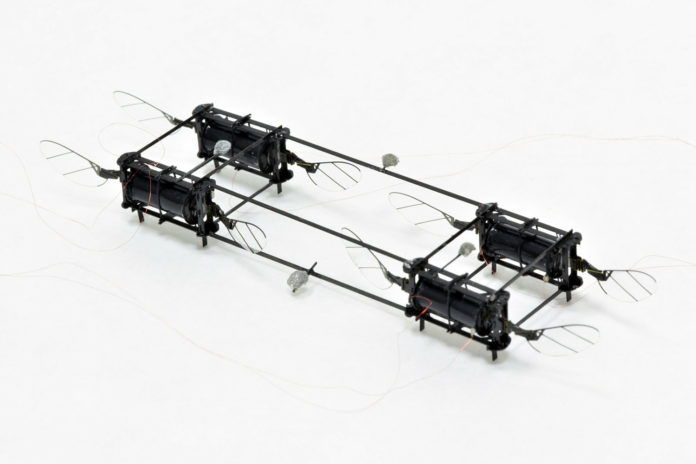Building insect-sized robots are one of the most challenging issues in robotics. While the four-winged robots are too heavy, the two-winged ones cannot fly evenly. But researchers haven’t given up, and now a team from Harvard John A. Paulson School of Engineering and Applied Science (SEAS) has come up with a new design called RoboBee. Thanks to its soft “artificial muscles” (actuators), the RoboBee does not get damaged when hitting the wall while flying.
RoboBee can crash into walls, fall onto the floor, and collide with other similar robots without being damaged. There have been flying insect robots made of this material before, but this example is the best so far in terms of power density and balanced flight. They claimed it is the first microrobot powered by soft actuators to achieve controlled flight.
The soft actuators are made with dielectric elastomers, which deform under the electric field and have good insulation properties. The improved electrode conductivity allows the RoboBee to operate at the same 500 Hz as the rigid actuators found in other robots of this size. They are also easy to install and replace.
Thus, it can be equipped with more blades and actuators to perform more complex tasks. To demonstrate various flight capabilities, the researchers built several different models of the soft-powered RoboBee. The model’s most controlled flight is achieved using four actuators and eight wings.
Smaller robot technology is still not efficient enough compared to traditional large-size robots. Researchers plan to continue developing RoboBees and eventually want to sell them. If they succeed, there will be countless uses. Researchers think this kind of robot might be helpful in search and rescue missions as they can easily travel through very narrow spaces and monitor weather or climate.
Their research is published in Nature. The idea of RoboBee is a project that has been studied for many years. Before that, Bee + appeared, and a prototype weighing 8.5 grams was allowed to fly.
Journal Reference
- Yufeng Chen, Huichan Zhao, Jie Mao, Pakpong Chirarattananon, E. Farrell Helbling, Nak-seung Patrick Hyun, David R. Clarke & Robert J. Wood. Controlled flight of a microrobot powered by soft artificial muscles. Nature volume 575, pages324–329 (2019) DOI: 10.1038/s41586-019-1737-7
